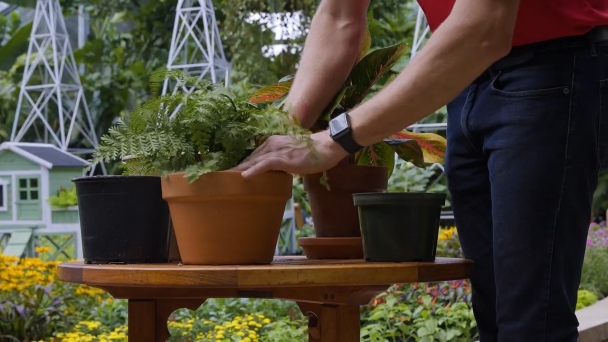Yard and Garden: Spring Houseplant Care

When repotting houseplants, the method matters. Starting with the right container. (Photos courtesy of ISU)
AMES, Iowa -- Houseplants provide beauty and green indoors throughout the year. As spring weather approaches and the days get warmer and longer, indoor plants can start thriving. Iowa State University Extension and Outreach horticulturists discuss what you can do with your houseplants now that spring has arrived.
How do you know it's time to repot a houseplant?
Frequent repotting is not always needed because most houseplants prefer to be slightly root-bound. It's time to repot when plants become top-heavy, growth slows and/or potting soil quickly dries out. Over time, potting soil will break down and become more compacted and poorly drained. This is another indication that it is time to repot.Repotting houseplants.
Potting or repotting can be done any time of the year. However, most gardeners have the best success doing it in late winter or early spring, as houseplants start growing more vigorously with the warmer temperatures and longer days of spring.
How do you repot a houseplant?
Start by finding the best container. When repotting, only move up one (maybe two) container sizes. Houseplants do not benefit from moving from super cramped quarters to overly large pots. Pick broad, wide-based containers for taller plants so they will be stable and less likely to tip.
To repot houseplants, remove the plant from the old container. Run a knife around the inside perimeter of the pot to make it easier to pull the root mass from the old container. Lightly break up the soil and remove limp, brown or dead roots.
Place a small amount of potting soil in the bottom of the new container. If needed, a small screen or broken pottery shard can be placed over a large drainage hole to prevent soil from falling out. In most cases, they are unnecessary and may clog or greatly slow the pot's drainage. Do not put gravel or rocks in the bottom of the container. This creates a wetter zone of soil closer to developing and growing roots, promoting root rot.
Place the root mass in the container and fill around the root ball with fresh potting soil. Lightly firm the soil to hold the plant in place. The top of the soil should be at least 1/4 to 1/2 inch lower than the container's rim. This creates an area for water to pool and soak in, making watering easier. Once finished, thoroughly water the plant.
Dust has accumulated on the foliage of my houseplants. How can I clean the plants?
Cleaning houseplants improves their appearance, stimulates growth and may help control insects and mites. Large-leaved plants may be cleaned with a mild dishwashing soap solution (add a few drops to lukewarm water) and a soft sponge or cloth. Plants can also be cleaned by placing them in the sink or shower and gently spraying them with lukewarm water. Be sure to adjust the pressure and water temperature before spraying the plants. African violets and other fuzzy-leaved plants can be cleaned with a damp, soft cloth or soft-bristled brush.
Pouring water into plant pot.When should I fertilize houseplants?
Spring and summer are the best times to fertilize houseplants. Fertilizers are available in liquid, crystalline, granular, spike and tablet forms. Use fertilizers specifically formulated for houseplants or use a complete all-purpose fertilizer. Mix all-purpose fertilizers at half or a quarter of the strength outlined in the instructions because houseplants grow slower than the outdoor plants the instructions on the fertilizer label are written for. When using fertilizers formulated for houseplants, mix at the concentration outlined on the label.
The frequency of application depends upon the product and varies from every two weeks to once every three to four months. Carefully read and follow label directions.
How do I move houseplants outdoors for the summer months?
When moved outside during the warm parts of the growing season, houseplants can flourish in the warm temperatures and high humidity of an Iowa summer. Indoor plants can safely be moved outdoors when nighttime temperatures are consistently and reliably above 50 degrees Fahenreheit (mid to late May).
Not all outdoor locations are suitable for houseplants. It is important not to move houseplants into too much light. Houseplants will do best if they "summer vacation" in full or part-shade outdoor locations.
Moving houseplants outside is a significant change in environmental conditions, so acclimating them is important. Never move houseplants from indoors to full sun. Leaf burn, discoloration and drop can occur. Acclimate houseplants to brighter locations by moving them from an indoor location to a full-shade location outside. Then, introduce more light over 10 to 14 days. Protect plants with some cloth or shade material if a full-shade location cannot be found. Many houseplants can be in full shade the entire summer, and others can be moved to a spot with part shade once acclimated.
Monitor plants closely, especially for the first several weeks. Even with the gentlest of transitions, some indoor plants, like weeping fig and tropical hibiscus, are prone to leaf drop when moved to a new location. New leaves will emerge in a couple of weeks to replace the ones lost.
Category:
The Eagle Grove Eagle
The Eagle Grove Eagle
P.O. Box 6
304 West Broadway
Eagle Grove, IA 50533
Phone: 1-515-448-4745
FAX: 1-515-448-3182
Email: news@eaglegroveeagle.com
Mid-America Publishing
This newspaper is part of the Mid-America Publishing Family. Please visit www.midampublishing.com for more information.